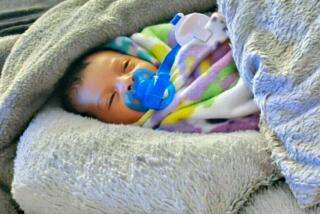Rethinking Joint Custody : Study Sparks New Debate About Whether It’s Always Best for the Child
- Share via
Four-year-old Kristin was in the bathtub singing when her father arrived to pick her up for the weekend. Catching a glimpse of his daughter’s suitcase, still empty on the living room floor, John trailed his wife, Evelyn, into the bathroom and accused her of deliberately delaying Kristin’s departure.
As their voices rose, Kristin shrank farther into the water, trying not to hear her mother call her father a “psychopath and a jerk” and her father call her mother a “whore.” Still roaring, John threatened to go back to court, seeking sole custody of Kristin. Evelyn threatened to flee the country, so that her former husband would “never set eyes on” his daughter again.
At her father’s house that weekend, Kristin was subdued and wet her bed all three nights. When she returned to school on Monday, in a burst of anger, she hit another child with her lunch box.
Sixteen months earlier in a bitter divorce, each parent had demanded sole custody of Kristin. Recognizing that mother and father had been loving parents, the court ordered joint custody. In addition to joint legal custody, requiring cooperation in making decisions, John and Evelyn also share joint physical custody, meaning Kristin lives half-time with each parent.
In theory, joint custody is preferable to sole custody because children are able to sustain relationships with both parents. But a recent study concluding that joint custody doesn’t necessarily benefit children is sparking lively debate among mental health professionals and will be among the topics considered today when the Assn. of Family and Conciliation Courts begins its 25th anniversary conference in Long Beach.
The research, conducted by the Center for the Family in Transition in Corte Madera, Calif., found that in amicable divorces, there was no difference in the child’s development whether in joint or single-parent custody. However, children whose parents had bitterly contested divorces were more psychologically disturbed if courts imposed joint physical custody. These children were significantly more depressed, withdrawn, uncommunicative, had more physical symptoms and tended to be more aggressive, the study found.
Psychologist Judith Wallerstein, the center’s executive director and a keynote speaker at this week’s association conference, said that nationwide, between 10% and 15% of divorcing couples are so angry that they cannot cooperate. “These are adults who cannot stop fighting. The more contact they have, the more they fight, and it escalates. The children become the shuttlecock in the war. Children are subjected to the parents’ threats, verbal abuse and physical violence. This makes children feel very vulnerable and unprotected, and it is destructive to the mental health of children,” she said.
The family dynamics can be complex. In some families, Wallerstein said, “parents are so intensely dependent on the children that the parents feel they cannot psychologically or physically share them.”
More important than the type of custody, Wallerstein believes, is the parents’ psychological functioning and the quality of the parent-child relationship.
Wallerstein, noting that the study reflects only the first two years following divorce, is cautious about the results. “You have to keep in mind that joint custody is a new family form. It may still be beneficial over the long haul, but that remains to be determined,” she said.
Debate about joint custody elicits strong feelings. Dr. John Leonard, a Los Angeles child psychiatrist and consultant for the Los Angeles County Department of Mental Health, takes a hard line. “There is absolutely too much joint legal custody and too much joint physical custody,” he said. “If parents are using the child as a pawn, I say you choose the most nurturing parent and award sole custody, and tell the other parent, ‘too bad.’ We have to protect these children,” he added.
Even though counseling angry divorced parents is “like being in the middle of a fist fight,” said Irene Goldenberg, director of psychological services at UCLA’s Neuropsychiatric Institute, “I still believe that even though it can be very tough for the child, joint custody tends to keep both parents involved, and in the long run, that is better for children.”
No Longer Radical
Before the late 1970s, joint custody, a grass-roots movement originating in California, was a radical idea. Since then, 33 states have passed legislation enabling courts to order joint custody. Although there is no reliable national data, in California, currently about 75% of divorcing couples are awarded joint legal custody.
Additionally, a recent Stanford University study of two Northern California counties found that joint physical custody accounted for nearly 18% of all arrangements.
Many divorcing couples do manage joint custody effectively. In 1977, Jane Glass of Burbank and Jim Glass, who now lives in Sepulveda, divorced. They amicably decided to share custody of David, who was 6, and Kathryn, 11.
When Jim Glass’ consulting work required relocation to San Diego for a few years, the children spent weekends and summers with their father. Later, Glass returned to the Los Angeles area and the children divided time between both parents’ homes. Throughout high school, Kathryn lived with her father, spending weekends with her mother.
In time, Jim Glass married Vicky Hart and became stepfather to her daughter, Kimberly Dawn Hart, now 15. Jane Glass married Ed Smith. The two families are on good terms, regularly spending the children’s birthdays and holidays together.
Glass noted that the arrangement makes for some interesting child-rearing discussions. “Sometimes, the adults will be talking and I realize that my former wife is championing the cause of my stepdaughter,” he said.
Not Always Easy
Immediately following divorce, the relationship wasn’t easy. “I think my former wife and I both subordinated our reactions to one another at times in order to ensure that the kids had a reasonably healthy environment. Kids are unwitting victims. You owe them that. They pay enough of a price,” he said.
Nevertheless, for many, putting differences aside seems impossible. Furthermore, experts say, divorcing adults rarely anticipate the complexity of the relationship with a former spouse.
“You don’t get divorced from someone, you get divorced to someone,” observes Hugh McIsaac, director of Family Court Services of Los Angeles Superior Court’s Conciliation Court. “You wish this person would disappear. But there are pediatric appointments, school conferences and Thanksgiving, and it is very difficult to separate the divorce and the spousal role from the parental role,” he said.
Eleanor Maccoby, a Stanford University psychology professor who teaches seminars on divorce and custody, takes McIsaac’s point a step farther.
“You can make the argument that joint custody is a form of partial divorce. You can be divorced in terms of sexual conduct, residence and to some extent your money, but joint custody says you are not divorced in regard to your children. You are expected to cooperate,” she said.
Constance Ahrons, a family therapist and professor of sociology at USC, thinks it is counterproductive to dwell on the continuing marital aspects. “People don’t want to accept this, but we are experiencing a societal change around marriage. What we have is serial monogamy. Large numbers of children will experience marital disruption. Instead of talking about marriage, the focus needs to be on responsible parenting,” she said.
For many, this is easier said than done. The divorce of one Los Angeles woman is instructive. When Barbara, who asked that her name not be used, discovered her husband had engaged in a long string of love affairs over a 3-year period, she sued for divorce and custody of the couple’s 3 1/2 year-old-son Craig.
Economic Reprisals
Steve, who didn’t want the divorce, was angry and his first reprisals were economic. Devising a new bookkeeping system for his prosperous business, he claimed he earned only $20,000 a year. Since the divorce was finalized a year ago, he hasn’t paid any of the $275-a-month, court-ordered child-support payments. Barbara, who now lives in a small, rented house, provides for herself and Craig with her earnings as an office worker.
Currently, Steve lives with another woman and her young son, whom he supports financially. He drives a new car and takes his woman friend on ski trips and to concerts.
A few months ago, there was a violent episode. Steve’s woman friend incorrectly relayed a message to him about what time to pick up Craig, causing Steve to wait for half an hour. He was so angry, that when Barbara arrived, he threw her against the car. Since then, Barbara hasn’t been present at pick-up times. She drops her son at school or with a relative.
Clearly, she is in a terrible dilemma, having to make decisions and cooperate with a man she now loathes, while at the same time wanting what is best for her child. “I don’t approve of my former husband’s life style or behavior. However, if I want my child to have a relationship with this man, I have to be very careful about what I say about his father,” she said.
Based on the above description, psychiatrist Leonard would question the value of this father-son relationship. Acknowledging that he doesn’t know the family, Leonard points out there is another way to look at this picture. “Do we really want this little boy identifying with this man? We know the father isn’t responsible and is abusive to the mother. Society already has raised one man like that. We don’t need another one,” he said emphatically.
In Los Angeles, roughly 95% of divorcing couples reach custody agreements either by themselves or through court mediation services. For the remaining 5%, the judge is the final arbiter.
Judge Richard Montes of Los Angeles Superior Court said he tries to determine what is most conducive to the child’s emotional well being. Cognizant that he sees adults at their worst, Montes said he deliberates very carefully. “With very angry people, it is hard to tell whether anger will dissipate, and if so, how much,” he said.
Marilyn Coleman, chairman of the Child and Family Development Department at the University of Missouri, Columbia, adds still another unknown to the equation. Coleman notes that custody is based on what is best for a child at the time of divorce. However, she said, many of these children will later become part of step-parent families.
“I don’t think we know the effect of joint custody on the integration of step-families. For example, if there is a joint custody arrangement, does the step-parent bond as closely, or move away from that child? That’s just part of what we don’t know,” she said.
As one family therapist put it, “When you decide the fate of children following divorce, no matter what you decide, the children are harmed.”
However, Constance Ahrons argues, in the generation before divorce was prevalent, “Children paid the tremendous price of being raised in highly conflictual homes with parents who had no love or contact with one another. I can’t tell you how many adults I have seen in therapy who tell me ‘I wish my parents had divorced,’ ” Ahrons said.
More to Read
Sign up for Essential California
The most important California stories and recommendations in your inbox every morning.
You may occasionally receive promotional content from the Los Angeles Times.










